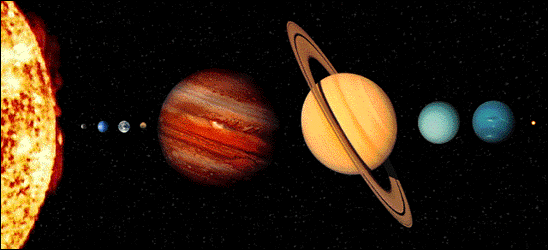The Scale of the Universe

| Gene Smith's Astronomy Tutorial The Scale of the Universe |


 The Atom -- The basic unit of each chemical element is the
atom. Atoms have a large nucleus, composed of
protons and neutrons held together by the
Strong Force. The electrons "orbit"
the nucleus, attracted by the
Electrical Force.
The Atom -- The basic unit of each chemical element is the
atom. Atoms have a large nucleus, composed of
protons and neutrons held together by the
Strong Force. The electrons "orbit"
the nucleus, attracted by the
Electrical Force.
| Atomic Particles | |||||
|---|---|---|---|---|---|
| Particle | Symbol | Charge | Mass ( | Mass ( | Family |
| proton | p+ | +1 | 1.673 x 10-24 | 1.00727 | baryon |
| neutron | n0 | 0 | 1.675 x 10-24 | 1.00866 | baryon |
| electron | e- | -1 | 9.109 x 10-28 | 5.485 x 10-4 | lepton |
 Atomic Nuclues - ~10-13cm.
Atomic Nuclues - ~10-13cm.
 Size of Atom - the radius of the first electron "orbit" in
the Hydrogen atom is
1/2Å = 0.5 x 10-8cm.
Size of Atom - the radius of the first electron "orbit" in
the Hydrogen atom is
1/2Å = 0.5 x 10-8cm.
 Molecules - Atoms build themselves into molecules
(e.g. H2O) with sizes ranging
from a few Å up to 10
Molecules - Atoms build themselves into molecules
(e.g. H2O) with sizes ranging
from a few Å up to 10
 Cells - 10-2 cm.
Cells - 10-2 cm.
 Humans - The largest humans who don't play basketball are
about 2 meters ( = 200 cm) in size; Professor
Smith is 186 cm in height.
Humans - The largest humans who don't play basketball are
about 2 meters ( = 200 cm) in size; Professor
Smith is 186 cm in height.
 The Earth - The Earth is about 25,000 miles around, which
makes its radius about 4000 miles. More
precisely, the radius at the equator, RE
= 6378 km = 6.378 x 108 cm.
In other words, it would take about 7 million
people to span the distance from San Diego to
China through the center of the Earth.
The Earth - The Earth is about 25,000 miles around, which
makes its radius about 4000 miles. More
precisely, the radius at the equator, RE
= 6378 km = 6.378 x 108 cm.
In other words, it would take about 7 million
people to span the distance from San Diego to
China through the center of the Earth.
 The Sun - The Sun, our nearest star is 93 million miles =
150 million km = 1.5 x 1013cm away.
Its radius , RS = 7 x 1010cm.
The Sun - The Sun, our nearest star is 93 million miles =
150 million km = 1.5 x 1013cm away.
Its radius , RS = 7 x 1010cm.
If the sun were a large grapefruit (r~ 7 cm), the Earth would be a pinhead 15 meters away.

 The Stars - The nearest star, Alpha Centauri, is a triple
star system in the constellation Centaurus. It
is only visible from the Southern Hemisphere.
The distance to Alpha Centauri is 4.34 light-
years = 4 x 1018cm.
The Stars - The nearest star, Alpha Centauri, is a triple
star system in the constellation Centaurus. It
is only visible from the Southern Hemisphere.
The distance to Alpha Centauri is 4.34 light-
years = 4 x 1018cm.
A light-year is the distance that light travels in one year:

 The Galaxy - The Sun is one of the 500,000,000,000 stars in
the Milky Way Galaxy. The Milky Way is about
100,000 light-years = 1023cm across.
The Galaxy - The Sun is one of the 500,000,000,000 stars in
the Milky Way Galaxy. The Milky Way is about
100,000 light-years = 1023cm across.
 Other Galaxies - The Andromeda Galaxy, our nearest sizeable
neighbor, is about 2 million light-years
= 2 x 1024cm away.
Other Galaxies - The Andromeda Galaxy, our nearest sizeable
neighbor, is about 2 million light-years
= 2 x 1024cm away.
 The Universe - 1027cm: There may not be a "size"
to the Universe; it may be infinite. But, a
crude estimate of the scale of the Universe
can be made from looking back to the
"beginning". Astronomers believe that the
Universe began with the Big Bang,some
10 - 20 billion years ago. So, the most
distant objects that we can see are about 10
- 20 billion light-years (= 1027
cm) away.
The Universe - 1027cm: There may not be a "size"
to the Universe; it may be infinite. But, a
crude estimate of the scale of the Universe
can be made from looking back to the
"beginning". Astronomers believe that the
Universe began with the Big Bang,some
10 - 20 billion years ago. So, the most
distant objects that we can see are about 10
- 20 billion light-years (= 1027
cm) away.

![]() Through the Universe at the Speed of Light
Through the Universe at the Speed of Light
![]() Education & Outreach
Education & Outreach
![]() CASS Home
CASS Home